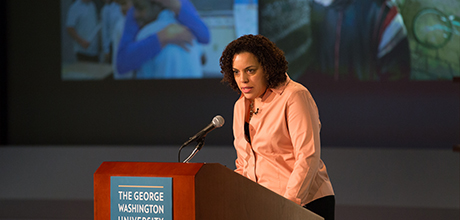The importance of mental health can’t be understated. This Mental Health Awareness Month, Olga Acosta Price, an associate professor in the School of Public Health and Health Services and director of the Center for Health and Health Care in Schools, details why mental health is so critical to the overall wellbeing of the nation.
Dr. Price and her colleagues recently released a report about improving access to children’s mental health care based on a study of 11 states. She spoke with George Washington Today about the importance of openly discussing mental health, illness risk factors and interventions.
Q: How do you define mental health?
A: When I think about mental health, I really define it in the broadest sense of the term. Many times, when you say “mental health,” the listener hears “mental illness.” I view mental health in the same way as physical health. Just as we all have physical health, and sometimes develop illnesses, we all have mental health, and sometimes we develop illnesses. As with physical health problems, mental health problems can often be effectively addressed with accurate information, access to appropriate care and through ongoing support.
Q: What are generalizations people tend to make about mental illness?
A: We need to move away from viewing mental illness as something “others” have. It’s something that, given different kinds of circumstances and conditions, we might all develop to a degree.
Q: Why is it important to openly discuss mental health?
A: I think that if we could have public and private dialogues in the various contexts in which we live, we can eliminate or decrease individuals feeling that they have to hide or minimize their own symptoms. There’s nothing wrong with an individual suffering a mental illness. We need to make sure we’re not blaming someone for something that is out of their control.
Q: What are the most common types of mental illness?
A: The first ones that come to mind are depression and anxiety. The No. 1 cause of disability worldwide is depression. Most of us can relate to what that means. It is important, too, to remember there are various degrees of depression. Some folks have depressive episodes or chronic depression that they might suffer with most of their life. That goes for children too. Adults have a very difficult time thinking children might be depressed or anxious to the degree that it might be hard to function or live up to their fullest potential.
Q: What are various risk factors for developing a mental illness?
A: Social factors like violence, poverty and feeling unsafe in your community or your home can have a very serious impact on mental health. Genetic predisposition to a mental illness is also a risk factor. It’s not to say these factors will definitely lead to a mental illness, but often they contribute.
Q: How can we reduce those risk factors, particularly the social ones?
A: Our response has to be around improving access and reducing barriers to quality care such as financial obstacles and a shortage of mental health professionals.
The issue of poverty and economic disparities in communities involves a complex set of issues to untangle and address. So the solutions need to be multifaceted. We need to figure out what’s our individual, government, public and community responsibility? We all have a role to play in creating environments that can promote emotional wellbeing.
Q: Do you see any particular solution as especially important?
A: The thing that jumps out to me, especially in light of recent national events, is that we have to create environments that promote safety for children and adults. We need to think, “OK, if we look at each setting that an individual lives in—the home, neighborhood, school or workplace—how safe do they feel? What can we do to promote a sense of security and facilitate healthy connections with each other? If young people live in an environment where there’s so much stress on the family and the family can’t cope, the children might be at a higher risk for neglect or abuse and, therefore, may later develop a mental illness.
Our approach can’t be one that just identifies and punishes. That approach limits us. We should certainly have laws, and we should have enforcement. But that becomes limiting because you’re reacting and responding as opposed to thinking ahead and preventing and promoting the positive things and the strengths that we can build on in our homes and neighborhoods. It has to be that kind of integrated solution.
Q: What types of initiatives do you work on surrounding mental health?
A: My area of specialization is school mental health, so I’m interested in the role that the climate of a school, as well as the individuals in the school—both adults and youth—play in allowing kids and their families to be the most successful they can be. That may be done through prevention or early intervention programs, through integrated services delivered in schools, or through healthy school policies, for example. We also want to look to adults and how to maximize their health, because they’re the conduits through which children develop and learn to maintain their mental health.
Q: What are some warning signs that might indicate you should help a loved one seek help for a mental illness?
A: Sudden or subtle changes in mood, in activity level, in interest in things, in behavior or appearance, in outlook on life—those kinds of changes should raise red flags. It doesn’t mean that there’s a problem but it might be a warning sign to further investigate with a loved one.
The second part here is that it is equally important to know what to do next. Where would you go for help? Who would you go to? Knowing what resources are in your community—the schools, providers, hotlines and doctors—is critical.


